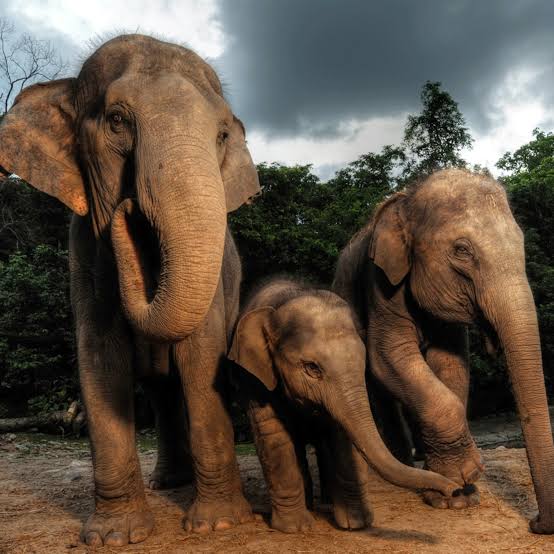
Elephants are smart animals with strong feelings and they often work together. In India’s Bengal area, scientists found that elephants buried five baby elephants, according to a study published in the Journal of Threatened Taxa.
Researchers have limited the study of elephant thanatology—the examination of death and related practices— to the burial of calves. Observers had noted this aspect of behaviour in African elephants but had not documented something similar in Asian elephants until recently, despite both species diverging 4.2 million years ago.
The researchers wanted to clear up the second question – do Asian elephants, like African elephants, mourn their dead calves? And the answer is yes, and it is loud. The vocalizations from the elephants lasted between 30 and 40 minutes, but only in places far from human settlements.
They point out that this behaviour suggests elephants distinguish human spaces from non-human spaces to avoid disagreements. They also mention that elephants limited vocalisation to the burial phase.
The increasing encroachment of human activities into natural habitats and the resulting environmental degradation are forcing elephants to venture into human-dominated areas in search of food and other ecological necessities. This interaction has led to new behaviours in these majestic creatures.
Asian Elephants’ mourning behaviour
Parveen Kaswan, an officer with the Indian Forest Service, and Akashdeep Roy, a researcher at the Indian Institute of Science Education and Research, spent 16 months reviewing literature relating to elephant burials. They found five case reports that document this behaviour.

Researchers have revealed that Asian elephants, similar to their African counterparts, engage in what we can describe as mourning rituals. Observations showed them vocalising loudly and burying their deceased calves, exhibiting a level of ritualistic behaviour that parallels human funeral rites.
The study reports a heartbreaking journey of a mother elephant. The mother elephant carried her dead calf for two days before letting it go. This extended time of grieving shows the deep attachment between mother elephants and their offspring. This could have been made stronger possibly by hormonal influences like oxytocin and the long gestation period elephants experience. This response is consistent with other studies on chacma baboons, olive baboons, African elephants and Thornicroft’s giraffes.
As per the study, the burial process is a collective effort, involving not only the mothers but also other females within the herd who act as surrogate caregivers, as well as elephants of various ages. This communal participation underscores the intricate social fabric of elephant herds and their collective mourning when faced with death. Notably, this ritualistic burial is reserved exclusively for the young. The physical impracticality of carrying the larger, heavier adults precludes them from receiving the same rite. This selective practice indicates that the elephants’ mourning and burial customs are particularly significant for the young, whose passing deeply impacts the social structure of the herd.
Compassionate behaviour
The research aimed to understand the ‘perimortem’ strategy and ‘postmortem’ behaviour of Asian elephants. The main evidence shows that someone or something transported the corpses from afar, treated with great care. They buried the corpses in preferred locations, always in a specific posture, which was an unusual lying position with legs upright.
The author said, “Our study found an interesting thing – the placement of carcasses with their paws raised in narrow irrigation drains. This strategic behaviour shows the care and affection of herd members toward the deceased animal and suggests that in a potential crush situation, pack members prioritize the head over the feet,” they highlight.”
“Elephants are social and affectionate animals and, based on an external examination of the carcasses, we also suggest that herd members gently placed the dead calves by grasping one or more legs,” the experts conclude.
The authors of the report thoroughly investigated the underlying reason for the death of the offspring through postmortem examinations. One of the conclusions is that there was no direct human intervention in any of the five deaths.

“Through direct and indirect evidence, this study highlights compassionate and helpful elephants’s behaviour during carcass burial. Asian elephants transport their deceased calves to isolated places, away from humans and carnivores, while searching for drains irrigation and depressions to bury the body,” the report states.
No infanticide among Asian elephants
Many animal groups, such as monkeys, meat-eaters, and rodents, commit infanticide or baby killing. Different reasons, such as elimination of competition, scarcity of resources, or maintaining social order within a group, contribute to this phenomenon.
However, the researchers found that there was no infanticide among the Asian elephants. They believe there are a few reasons why elephants don’t kill babies:
- Elephants, particularly females and their young, live in close family groups forming strong bonds. This closeness possibly prevents them from hurting the young, actively encouraging them to cooperate in caring for them.
- Baby elephants require long term care from their mothers and other females in the herd. This extended care and help from everyone might decrease the likelihood of someone killing a baby.

- In the breeding process, elephants reproduce without having to kill their babies to quicken the mother’s readiness for another offspring. Unlike some other animals, the mother cannot immediately have another offspring if she loses a baby. Thereby, eradicating the need for males to kill babies.
- Male elephants neither directly contribute to raising the babies nor participate in the close female groups. They prioritize finding females ready to mate rather than assuming control over a herd and eliminating other males’ babies. This social structure and breeding style decreases the likelihood of elephants killing babies.
Complete Article ↪HERE↩!
